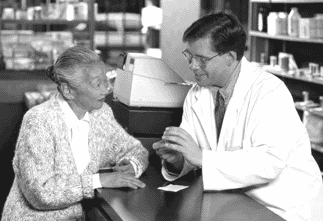
Treating prescription drug addiction
Years of research have shown
us that addiction to any drug
(illicit or prescribed) is a brain
disease that, like other chronic
diseases, can be treated
effectively. No single type of
treatment is appropriate for
all individuals addicted to
prescription drugs. Treatment
must take into account the
type of drug used and the
needs of the individual.
Successful treatment may
need to incorporate several
components, including detoxification,
counseling, and in
some cases, the use of pharmacological
therapies. Multiple
courses of treatment may be
needed for the patient to
make a full recovery.
 |
The two main categories
of drug addiction treatment
are behavioral and pharmacological.
Behavioral treatments
encourage patients to stop
drug use and teach them how
to function without drugs,
handle cravings, avoid drugs
and situations that could lead
to drug use, and handle a
relapse should it occur. When
delivered effectively, behavioral
treatments-such as individual
counseling, group or family
counseling, contingency
management, and cognitiveÐ
behavioral therapiesÑalso
can help patients improve
their personal relationships
and their ability to function at
work and in the community.
Some addictions, such
as opioid addiction, can be
treated with medications.
These pharmacological treatments
counter the effects of
the drug on the brain and
behavior, and can be used to
relieve withdrawal symptoms,
treat an overdose, or help
overcome drug cravings.
Although a behavioral or
pharmacological approach
alone may be effective for
treating drug addiction,
research shows that, at least
in the case of opioid addiction,
a combination of both
is most effective.
Treating addiction
to prescription opioids
Several options are available
for effectively treating prescription
opioid addiction.
These options are drawn from
research regarding the treatment
of heroin addiction,
and include medications such
as naltrexone, methadone,
and buprenorphine, as well
as behavioral counseling
approaches.
Naltrexone is a medication
that blocks the effects of
opioids and is used to treat
opioid overdose and addiction.
Methadone is a synthetic
opioid that blocks the effects
of heroin and other opioids,
eliminates withdrawal
symptoms, and relieves drug
craving. It has been used
successfully for more than
30 years to treat heroin
addiction. The Food and Drug
Administration (FDA) approved
buprenorphine in October
2002, after more than a decade
of research supported by
NIDA. Buprenorphine, which
can be prescribed by certified
physicians in an office setting,
is long lasting, less likely to
cause respiratory depression
than other drugs, and is well
tolerated. However, more
research is needed to determine
the effectiveness of these
medications for the treatment
of prescription drug abuse.
A useful precursor to longterm
treatment of opioid
addiction is detoxification.
Detoxification in itself is not a
treatment. Rather, its primary
objective is to relieve withdrawal
symptoms while the
patient adjusts to being drug
free. To be effective, detoxification
must precede long-term
treatment that either requires
complete abstinence or incorporates
a medication, such as
methadone or buprenorphine,
into the treatment program.
Treating addiction
to CNS depressants
Patients addicted to barbiturates
and benzodiazepines
should not attempt to stop
taking them on their own.
Withdrawal symptoms
from these drugs can be
problematic, andÑin the case
of certain CNS depressants-
potentially life-threatening.
Although no research regarding
the treatment of barbiturate
and benzodiazepine addiction
exists, addicted patients
should undergo medically
supervised detoxification
because the treatment dose
must be gradually tapered.
Inpatient or outpatient counseling
can help the individual
during this process. Cognitivebehavioral
therapy, which
focuses on modifying the
patient's thinking, expectations,
and behaviors, while at
the same time increasing skills
for coping with various life
stressors, also has been used
successfully to help individuals
adapt to the discontinuation
of benzodiazepines.
Often barbiturate and benzodiazepine
abuse occurs in
conjunction with the abuse of
another substance or drug, such as alcohol or cocaine.
In these cases of polydrug
abuse, the treatment approach
must address the multiple
addictions.
Treating addiction
to prescription stimulants
Treatment of addiction to
prescription stimulants, such
as Ritalin, is often based on
behavioral therapies that have
proven effective in treating
cocaine and methamphetamine
addiction. At this time, there
are no proven medications
for the treatment of stimulant
addiction. However, NIDA is
supporting a number of studies
on potential medications for
treating stimulant addiction.
Depending on the patient's
situation, the first steps in
treating prescription stimulant
addiction may be tapering the
drug dosage and attempting
to ease withdrawal symptoms.
The detoxification process
could then be followed by one
of many behavioral therapies.
Contingency management,
for example, uses a system
that enables patients to earn
vouchers for drug-free urine
tests. (These vouchers can
be exchanged for items that
promote healthy living.)
Cognitive-behavioral therapy
also may be an effective
treatment for addressing
stimulant addiction. Finally,
recovery support groups
may be helpful in conjunction
with behavioral therapy.
|